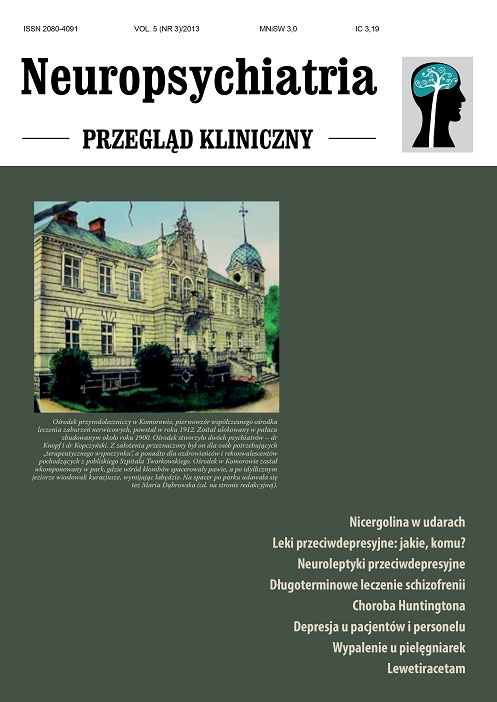Zastosowanie nicergoliny u pacjentów po przebytym udarze niedokrwiennym mózgu Artykuł przeglądowy
##plugins.themes.bootstrap3.article.main##
Abstrakt
Udar mózgu jest ogromnym problemem medycznym i społecznym. Stanowi on przyczynę długotrwałej niesprawności i inwalidztwa w dorosłej populacji na całym świecie. W artykule podjęto próbę oceny możliwości zastosowania nicergoliny u pacjentów po udarze mózgu i ewentualnych korzyści wynikających z takiego działania.
##plugins.themes.bootstrap3.article.details##

Utwór dostępny jest na licencji Creative Commons Uznanie autorstwa – Użycie niekomercyjne – Bez utworów zależnych 4.0 Międzynarodowe.
Copyright: © Medical Education sp. z o.o. License allowing third parties to copy and redistribute the material in any medium or format and to remix, transform, and build upon the material, provided the original work is properly cited and states its license.
Address reprint requests to: Medical Education, Marcin Kuźma (marcin.kuzma@mededu.pl)
Bibliografia
2. World Health Organization. The atlas of heart diseases and stroke. WHO, Genewa 2004.
3. World Health Organization. Global Burden of Diseases 2004 update. WHO, Genewa 2008.
4. Główny Urząd Statystyczny: Stan Zdrowia Ludności Polski w roku 2004. Warszawa 2006.
5. Sprawozdanie z Europejskiego Spotkania w Sprawie Ustalenia Wspólnego Stanowiska Dotyczącego Postępowania w Udarze Mózgu.
6. Niewada M, Skowrońska M, Ryglewicz D et al. Acute Ischemic Stroke Care and Outcome in Centers Participating in the Polish National Stroke Prevention and Treatment Registry. Stroke 2006; 37: 1837-1843.
7. Członkowska A. Co nowego w leczeniu udaru niedokrwiennego mózgu? Nowa Klinika 1997; 4: 605-610.
8. Whisnant JP, Basford JR, Bernstein EF et al. Special report from the National Institute of Neurological Disorders and Stroke. Classification of cerebrovascular diseases III. Stroke 1990; 21: 637-676.
9. Adams HP Jr, Bendixen BH, Kappelle LJ et al. Classification of subtype of acute ischemic stroke. Definitions for use in a multicenter clinical trial. TOAST. Acute Stroke Treatment. Stroke 1993; 24: 35-41.
10. Warlow C, Sudlow C, Dennis M et al. Stroke. Lancet 2003; 362: 1211-1224.
11. Szczudlik A, Członkowska A, Kwieciński H, Słowik A (red). Udar mózgu. Wydawnictwo Uniwersytetu Jagiellońskiego; Kraków 2007; 85-95.
12. Yamamoto H, Bogousslavsky J: Mechanisms of second and further strokes. Neurol Neurosurg Psychiatry 1998; 64: 771-776.
13. Dhamoon MS, Moon YP, Paik MC et al. Long-term Functional Recovery After First Ischemic Stroke: The Northern Manhattan Study. Stroke 2009; 40: 2805-2811.
14. World Health Organization. ICF – International Classification of Functioning, Disability and Health. WHO, Genewa 2001.
15. Moretti A, Carfagna N, Caccia C: Neurochemical effects of ergoline derivatives. W: Heidrich H (red). Proof of therapeutical effectiveness of nootropic and vasoactive drug. Springer-Verlag; Berlin 1986: 103-110.
16. Ogawa N, Asanuma M, Hirata H et al. Cholinergic deficits in aged rat brain are corrected with nicergoline. Arch Geront Geriatr 1993; 16: 103-110.
17. Carfagna N, Cavanus S, Damiani D et al. Modulation of phosphoinositide turnover by chronic nicergoline in rat brain. Neurosci Lett 1996; 209: 189-192.
18. Iadecola C. Regulation of the cerebral microcirculation during neural activity: is nitric oxide the missing link. Trends Neurosci 1993; 16: 206-214.
19. Nishio T, Sunohara N, Furukawa S et al. Repeated injection of nicergoline increase the nerve growth factor level in the aged rat brain. Jpn J Pharmacol 1998; 76: 321-323.
20. Nishiyama Y, Abe A, Ueda M et al. Nicergoline increases serum substance P levels in patients with an ischaemic stroke. Cerebrovasc Dis 2010; 29: 194-198.
21. Herpfer I, Lieb K. Substance P and substance P receptor antagonists in the pathogenesis and treatment of effective disorders. World J Biol Psychiatry 2003; 4: 56-63.
22. Mantyh PW. Neurobiology of substance P and the NK1 receptor. J Clin Psychiatry 2001; 63 (supl 11): 6-10.
23. Colledge NR, Barr-Hamilton Rm, Lewis SJ et al. Evaluation of investigations to diagnose the cause of dizziness in elderly people: a community based controlled study. BMJ 1996; 313: 788-792.
24. Winblad B, Fiorawanti M, Dolezal T et al. Therapeutic use of nicergoline. Clin Drug Investig 2008; 28: 533-552.
25. Heuschmann PW, Wiedmann S, Wellwood I et al. Three month stroke outcome: the European Registers of Stroke (EROS) investigators. Neurology 2011; 76: 159-165.
26. Nishiyama Y, Komaba Y, Mizumura S et al. Antidepressive Effect of Nicergoline on Patients with Mild Post-stroke Depression. Cerebral Blood Flow and Metabolism 2005; 17: 11-16.

